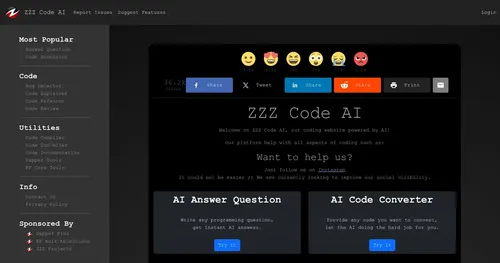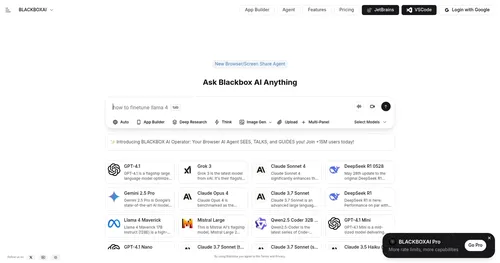Shuttle AI

Shuttle AI feels like a magic wand for developers who’ve ever stared at a blank code editor, wondering how to spin up a cloud app without drowning in infrastructure setup. This platform takes a bold swing at simplifying app development, letting you type a natural language prompt — like “build me a task-management API” — and poof, it delivers a working backend, deployed in under five minutes. It’s built around Rust, a programming language that’s fast, safe, and loved by engineers for its reliability. I think what makes Shuttle AI stand out is its promise to handle the messy stuff — code generation, infrastructure provisioning, and deployment — so you can focus on crafting ideas.
The process is surprisingly straightforward. You type a prompt, and Shuttle AI’s agents analyze it, generate Rust-based code, provision cloud resources, and deploy the app. The platform’s documentation and starter templates make it approachable, even if Rust isn’t your daily driver. Features like instant app deployment and error-correcting compilation agents mean you’re not stuck debugging infrastructure woes. It’s a time-saver, no question, and the Rust backbone ensures your app runs efficiently. For developers used to wrestling with Docker configs or cloud dashboards, this feels like a breath of fresh air.
That said, it’s not perfect. Shuttle AI’s beta status means it’s still ironing out kinks. Some users on Reddit mention occasional hiccups with complex prompts, where the AI misinterprets requirements, requiring manual tweaks. The platform’s heavy focus on Rust might also feel limiting if you’re more comfortable with, say, Python or JavaScript. Compared to competitors like Vercel or Render, which support a broader range of languages, Shuttle AI’s niche approach could be a dealbreaker for some. Vercel, for instance, excels at front-end deployments, while Render offers flexible language support. Shuttle AI, though, carves its niche with AI-driven automation for Rust backends.
What surprises me is the community vibe. Shuttle AI’s Discord is buzzing with developers sharing tips and starters, which adds a layer of support you don’t always get with other platforms. The tool’s resource library, packed with guides and examples, also helps you hit the ground running. Pricing-wise, Shuttle AI operates on a waitlist for its beta, suggesting a freemium model, though details are sparse. Competitors like Vercel and Render offer clearer pricing tiers, which might appeal to budget-conscious teams. Still, the speed of going from idea to deployed app is hard to beat.
If you’re diving into Shuttle AI, start with simple prompts to test the waters. Play with the starter templates to get a feel for Rust, and join the Discord community for quick help. Don’t expect it to handle every edge case perfectly — it’s still evolving. But for rapid prototyping or spinning up a backend without infrastructure headaches, give it a whirl. You might find it’s just the shortcut you need.
Video Overview ▶️
What are the key features? ⭐
- AI-Driven Code Generation: Creates Rust-based code from natural language prompts for rapid app development.
- Infrastructure Provisioning: Automatically sets up cloud resources for seamless app deployment.
- Deployment Automation: Deploys apps to Shuttle’s cloud in under five minutes with minimal user input.
- Rust Support: Leverages Rust’s performance and reliability for backend development.
- Resource Library: Offers documentation, guides, and starter templates for easy onboarding.
Who is it for? 🤔
Examples of what you can use it for 💭
- Solo Developer: Builds a task-management API quickly using a single prompt for rapid prototyping.
- Startup Team: Deploys a scalable backend for a new app without configuring cloud infrastructure.
- Project Manager: Reduces development timelines by automating code and deployment processes.
- Rust Enthusiast: Experiments with Rust frameworks like Axum using starter templates.
- Educator: Teaches students cloud app development with simplified, AI-driven tools.
Pros & Cons ⚖️
- Fast app deployment in under 5 minutes.
- Simplifies infrastructure management.
- Strong Rust performance and reliability.
- Limited to Rust-based development.
FAQs 💬
Related tools ↙️
-
Comfy Create images, videos, 3D models, and audio using a modular, node-based AI workflow
-
 ZZZ Code AI
A set of tools offering code generation & explanation, bug detector, code review, documentation, and more
ZZZ Code AI
A set of tools offering code generation & explanation, bug detector, code review, documentation, and more
-
UBOS Simplifies building AI-powered apps with low-code/no-code tools
-
Zeabur Deploy code & services effortlessly with one-click automations
-
 BlackBox AI
Helps programmers "code as fast as they think"
BlackBox AI
Helps programmers "code as fast as they think"
-
Requesty Routes AI requests to optimal LLMs with analytics

